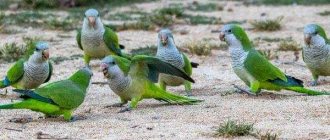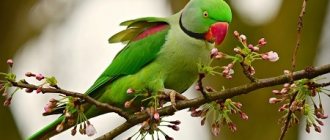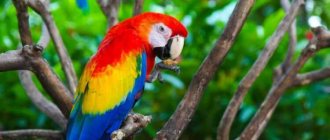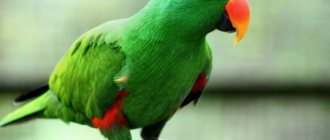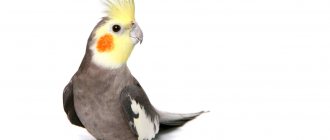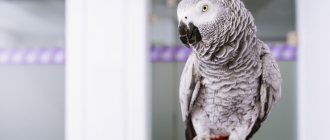- Wild animals
- >>
- Birds
Budgerigar - has a greenish-yellow coloration with black wavy markings on the back of the head, back and wings. In captivity they are bred with blue, white, yellow, gray coloring and even small combs. Budgerigars were first discovered in 1805 and have become extremely popular pets due to their small size, reasonable price, and ability to imitate human speech. Birds are the third most popular pet after domesticated dogs and cats. They have been bred in captivity since the 19th century.
Let's go choose a budgie
This issue is important and needs to be taken seriously. The best option would be to contact people who are professional breeders. If you purchase a bird at the market, the risk of buying a sick parrot increases.
Once you have made your choice, inspect the wavy. It should be active, have shiny, close-fitting feathers, and clear eyes. On the paws, two toes are directed forward, two are directed back, the scales on them should be even and adjacent to each other.
If the bird is not interested in what is happening, it is hunched, and the plumage near the anus is dirty with bowel movements, then the parrot is unhealthy.Take into account that young parrots up to 3-4 months old get used to the new environment and owners faster than older birds.
Food, light, nesting house
They say about budgerigars that they are undemanding birds. But during the breeding season they require special care.
The food is selected as varied as possible. Vitamin supplements are given in full. It is good to purchase a vitamin complex for nesting birds. It is important to prevent pets from becoming obese during this period.
Daylight hours are increased to 14 hours a day using lamp lighting. This encourages birds to nest.
How to support a couple and their offspring is an important question. For this you need a nesting house. This design is very similar to an ordinary birdhouse with a removable lid. The inside of the lower part must be lined with dry bark, hay, and twigs. The female will build a nest from them.
There lives a budgerigar, which has been carefully cared for and kept within the walls of the home for about 10 years. During this time, he will learn to speak and understand his owner. Communication with a pet will bring a lot of pleasure to a caring owner.
Determining the age of the bird
To prevent an unscrupulous seller from selling you an old bird under the guise of a new one, learn to independently distinguish a young parrot from an old one:
- Chicks up to two months old have a black “smear” on their beaks. Over time it will disappear.
- Chicks up to three months old have a noticeable wavy pattern on their heads, which disappears by 3.5-4 months after the first molt.
- Chicks have black eyes, from 5 to 10 months the iris becomes lighter, and older birds are distinguished by a pupil with a white rim.
- In young animals, the spots near the throat are fuzzy and semicircular; after six months they become oval and clear.
- Pay attention to the cere. In young birds it is a soft pink hue.
- The tail of older birds is longer than that of young birds.
These criteria do not apply to albinos (white color) and lutinos (yellow color). Such parrots always have black or dark red eyes and a light beak.
If you still decide to buy such a bird, contact a trusted seller.
Lifestyle
Wavys are school animals; the size of their flock can range from 20 to several hundred individuals with different bright colors. At the same time, you can see news that there were huge groups containing several thousand individuals. Wavyfish behave very noisily, especially in large flocks.
Birds move quite quickly; flight speeds can reach more than one hundred kilometers per hour. These are the fastest birds.
Thanks to their speed, wavy fish can easily avoid various predators.
The body color of the wavy allows it to hide in the thickets. Various seeds and berries are consumed as food. Birds can breed in any month, since Australia is quite warm and sunny. In some regions, wavy bugs begin to reproduce after the rainy season ends. At this time, a huge amount of food appears and there are no problems finding it.
The birds make their nests in the trees. The clutch consists of 4-12 eggs. The female is engaged in incubation, the male feeds his chosen one. After 3 weeks, the chicks begin to hatch, and after another month they are ready to leave the nest.
Who are you: male or female?
To determine the sex of a wavy, first of all, pay attention to the wax. All chicks have it pink, but if you look closely, you will see light rings around the circumference of the nostrils on the girls.
By 4 months the cere changes color. In boys it becomes blue, in girls it becomes beige or pale blue, and by 8-9 months it turns brown.Classification
According to I. Fisher's classification system, all budgerigars are divided into two groups.
The first group includes birds of any color with normal waviness, including four subgroups:
- Green with black wave pattern
- Blue with black wave pattern
- Yellow with a faint bluish wavy pattern
- White with a faint bluish wavy pattern
In these subgroups, 3 main tones of plumage are distinguished: light color, medium color, dark.
The second group includes parrots of variegated colors that have not retained the wavy pattern:
- Albinos
- Lutinos
- With opaline pattern
- With brown pattern
- Motleys
- Harlequins
- Lacewings
- Versatile
Crested budgies are placed in a separate group.
Criteria for choosing a cage
When approaching the question of choosing a home for a bird, consider the following factors:
- cell shape. A rectangular one with a flat roof would be ideal. It makes it easier for the parrot to move around and it will be easier to hang toys.
- size. Remember, the bird must freely straighten its wings and move around its home.
- twigs. To prevent your parrot from sliding along the walls, try to purchase a cage with twigs arranged horizontally.
- care and cleanliness. For ease of cleaning, choose a cage with a simple design. You need to clean every day, and do a general cleaning every month. You can disinfect the cage with chamomile infusion or wormwood infusion.
- safety. To prevent your bird from breaking its leg between the bars, buy a cage with a flat bottom.
Intelligence
Budgerigars are very intellectually developed. He can learn to speak and perform various tricks without any problems. In the absence of the owner for a long time, the wavy will be bored and sad, but at the same time he will try to make friends with other pets, if any. The feathered one trusts people, especially its owner.
Absolutely any family member can teach human speech and raise a wavy dog in general, no matter whether it is an adult or a child. The feathered bird can be a faithful companion to any owner. There is information that there was a wavy who knew about 1,700 words. This vocabulary is equal to that of a five-year-old child, but for a wavy this amount is quite enough.
This breed is one of the most active breeds that loves to interact with people and pets. Wavys can be taught a huge number of words, but, unfortunately, they will not be able to obtain conscious speech. They chirp not to maintain a conversation with the owner, but for their own pleasure.
The feathered one can learn to recite short poems.
What to put in the cage
To improve the comfort of your bird, install at least 2 perches of different diameters. The distance between them should ensure the free movement of the parrot from one perch to another. Please note that when placing perches, they should not be located above the feeder or drinker. Otherwise they will be contaminated with droppings.
When choosing a drinking bowl, give preference to glass or porcelain products. They keep the water fresh longer. Wash drinking bowls with soda every day and wipe dry.
Provide two feeders. One is needed for dry food, the other for treats. It's better to buy porcelain or plastic.
- Winter birds | Wintering birds
Owl - habitat, characteristics of species, family, diet, life expectancy (110 photos + video)
Pigeon - types and differences, features, flight, nutrition and reproduction + 88 photos
Bathing pads with warm water are placed in the cage periodically. After the parrot takes a “bath,” they need to be removed.
To prevent the bird from getting bored alone, hang a small mirror in the cage.
Remember that after purchasing a bird house and its accessories, be sure to rinse them with boiling water and dry them.
Bathing
Budgerigars come from tropical rainforests and require careful care. There are special fountains where water gurgles, and the birds can bathe and cleanse themselves. You need to bathe the bird once a week. In summer you can 2-3 times a week if it is very hot.
Parrots love water, so if they want to swim, the owner will understand. For shy birds, you can pour water into a saucer and place it next to the cage. Let your pet become interested and take a bath.
If the wings get dirty with paint or other chemicals while flying around the apartment, you should trim them carefully.
Food and feeding rules
Parrots eat more than just grains. Fruits and vegetables, herbs, and mineral supplements are also included in their mandatory diet.
Manufacturers add flax, oats, millet, and canary seed to grain feed. When choosing food, pay attention to the box. In sealed packaging with a “window” you can see the quality of the seeds, but in cardboard packaging mold often appears.
Among vegetables, budgies prefer carrots, beets, cabbage, cucumber, and zucchini. Fruits include apples, peach, pear and citrus fruits. Don't forget to add seasonal berries to your feeder.
Cormorant - how to recognize where it occurs, reproduction, appetites + 103 photos- Crane - origin, description, habitat and lifestyle, nutrition and reproduction + 79 photos
Heron - 89 photos of a very beautiful and rare bird
During the warm season, diversify your diet with grass. Plantain, dandelion, clover, spinach, and horse sorrel are perfect. During the cold season, you can grow oats or millet yourself.
You should not give your parrot meat and milk, dill, persimmon, any nuts, potatoes, celery root, chocolate and cheese.
Do not forget about mineral supplements: special sand, chalk or sepia. They not only enrich the body with microelements, but by gnawing on them, the bird wears down its ever-growing beak.
What you need to know before purchasing
Before purchasing a pet feathered friend, you need to prepare yourself for the fact that you will have to face difficulties while caring for budgies.
Birds wake up early - with the first rays of the sun, so the vibrant trills can already be heard at 5 - 7 am. Ask yourself: are you ready to wake up at such a time every day?
Parrots are partial to indoor plants, especially climbing ones. They bite leaves, dig in the ground, and climb stems. Noisy birds cannot sit in one place for a minute, so you will need to collect scattered feathers, seed husks and other debris throughout the house.
Is your parrot sick?
Improper care and handling of birds can cause the development of scabies, poisoning, inflammation of the goiter, damage to limbs, or infestation with down-eaters.
Signs of the disease for which you should immediately contact an ornithologist:
- ruffledness;
- refusal of food;
- loose stools;
- growths on the beak, around it, on the legs;
- discharge from the nostrils;
- lethargy and inactivity.
Spreading
Budgerigars are found in Australia. On this continent, birds are almost like pigeons; they are found both in the wild - forests, meadows, and in large cities. It is impossible to meet them only in the forests in the north. In 2021, the number of individuals has decreased greatly. The main fault lies with man, who constantly changes the nature of the places where birds live.
Poaching is also common, and various Aboriginal tribes consumed budgerigars as food. For these reasons, two centuries ago in Australia, a ban on the export of these birds was introduced at the state level. More individuals are kept at home than in the wild.
Photos of budgies
The most important thing is to choose a pet
Deciding on gender
With a boy, the learning process goes faster. As a result of long and systematic training, males can remember more than six hundred words. When the little one grows up, gets used to it, and gains certain knowledge, a mate is selected for him.
The female will willingly communicate with the native inhabitant of the cage, thus adopting his human speech skills.
You need to decide the gender of your parrot
Breeders claim that girls are no less smart, and therefore do not see the difference who appears in the apartment first.
However, we must not forget about the matriarchy that exists in the world of birds. The visiting male will have a hard time, but he will never offend his girlfriend.
The importance of a parrot's age
You need to buy a young individual, before the first molt. Then acclimatization and adaptation will be faster, and the pet will become firmly attached to the person. Young people frolic, are more curious, they are interested in everything new. It is especially useful to entrust the chick to children over ten years of age, this way they develop a sense of responsibility for our younger brothers.
One or more
If you place more than two budgies together, they will only communicate with each other. Why do they need people if they have relatives? Watching a flock of charming chirpers is, of course, fun and often touching, but it is impossible to teach them anything.
How many parrots is it advisable to take?
Which parrots should you choose?
We need a full-breasted, well-fed, active, and mobile specimen. With clean and even feathers, clear wavy lines on the back, a short tail, black eyes without gray edging, symmetrically located paws, purple or blue wax, which must be clean and completely dry.
What signs should you be wary of?
It would be right to abandon the lethargic, disheveled bird with a dull gaze from under half-open eyelids. She is unwell.
If it is red or dirty, you should also refrain from purchasing: most likely, the wavy has a problem with the digestive tract and poor metabolism.
A protruding sternum is a sign of exhaustion, and this, in turn, is always a consequence of a serious illness.
What signs should you pay attention to?
Rarely in budgies, a nasty disease called French molt occurs. This is when the great bird does not have all its flight feathers. In this case, it is better to look for another one. With such an illness, the tail feathers and flight feathers on the wings will never recover.


